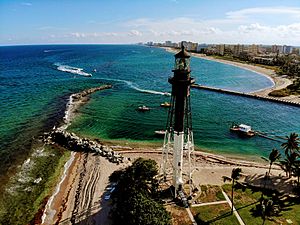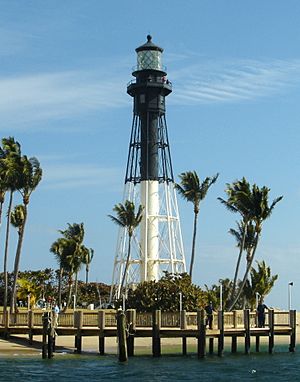Hillsboro Inlet Light facts for kids
 |
|
|
|
|
| Location | north side of Hillsboro Inlet |
|---|---|
| Coordinates | 26°15′32″N 80°4′51″W / 26.25889°N 80.08083°W |
| Year first constructed | 1907 |
| Year first lit | 1907 |
| Automated | 1974 |
| Foundation | iron piling |
| Construction | iron |
| Tower shape | octagonal skeletal with cylinder |
| Focal height | 136 feet (41 m) |
| Original lens | second-order bivalve Fresnel lens |
| Range | 28 nautical miles (52 km; 32 mi) |
| Characteristic | White, Flashing every 20 seconds |
The Hillsboro Inlet Lighthouse is a famous lighthouse in Florida. It stands on the north side of Hillsboro Inlet. This spot is about halfway between Fort Lauderdale and Boca Raton.
The lighthouse helps ships avoid the Florida Reef. This is an underwater coral formation along the state's lower east coast. It's a very important guide for boats in the area.
Contents
Lighthouse History
People first asked for a lighthouse at Hillsboro Inlet in 1884. This area was known to be dangerous for ships. For many years, the request was turned down.
Finally, in 1901, the United States Lighthouse Board convinced Congress. They agreed to build a lighthouse. It would fill a "dark area" between two other lighthouses. The plan was approved on February 12, 1901. It said a "first-order light" should be built for no more than $90,000.
Money was approved in 1902 and 1903. At first, a spot on the south side of the inlet was chosen. But it didn't work out. So, a new spot on the north side was picked. The land was bought for $150.
Early Challenges
Soon after the light started working, strange reports came in. People saw fires in the Everglades. It turned out the lighthouse lens was causing them! If the lens stopped in just the right spot in the morning, it would focus sunlight west. This sunlight hit the wetlands and started fires.
To fix this, a special shield was added. This shield also helped block the bright light from bothering nearby homes at night.
Life at the Lighthouse
Lighthouse keepers helped ships that crashed. They used small gas boats to reach them. The keepers' wives made sea grape jelly. They traded it with local farmers for pickled vegetables. During World War I, four Coast Guard signalmen lived at the lighthouse.
Surviving Storms and Wars
The lighthouse faced a huge challenge in the 1926 Miami hurricane. A keeper named J.B. Isler stayed on watch for 32 hours. He kept the light burning, even though he feared the lighthouse might fall. It stood strong, but the storm washed away 20 feet (6.1 m) of sand from under it. The storm also damaged homes and carried away the boathouse.
During World War II, in 1943, the lighthouse beach patrol saw a German U-boat. Later that year, a lighthouse keeper became suspicious of a freighter. The ship was carrying weapons and had German crew members. The ship was taken over and became a war prize.
Modern Changes
In 1974, the lighthouse became fully automated. This meant it could run by itself. Only one United States Coast Guard member stayed to maintain the light and grounds. The homes for assistant keepers became guest rooms. These were for senior Coast Guard and military officers.
The Hillsboro Inlet Light Station was added to the U.S. National Register of Historic Places on February 16, 1979. The lighthouse and its buildings still look much like they did when they were built in 1907.
Today, Hillsboro Inlet is a very busy waterway. The Hillsboro Inlet Light is one of the strongest lights in the world. Its beam can be seen for 28 nautical miles (52 km; 32 mi)!
The Lighthouse Tower
The lighthouse tower is made of iron. It has eight sides and looks like a pyramid. A company in Chicago built it for the 1904 St. Louis World's Fair. After the fair, the U.S. government bought it.
The metal parts were finished in 1907. Then, the tower was taken apart and moved to Hillsboro Inlet. A construction company cleared the land and built the foundations. They then put the lighthouse back together. The whole structure is held together with bolts, not welds. It uses 192 special cast iron joints and 80 tension rods.
The tower stands on eight concrete foundations in a 40 foot (12 m) circle. There is also a ninth foundation in the center. It has an iron frame with a central column. Inside the column are circular stairs. There was also space for weights that made the lens spin. The tower is 132 feet (40 m) tall. It was first lit on March 7, 1907. It is one of the oldest buildings in Broward County.
The lower part of the lighthouse is painted white. The upper two-thirds and the top lantern part are black. This helps it stand out during the day. The lighthouse has a cast iron roof. The main entrance faces north. The watch room inside has wood floors and ceiling. It also has five large windows.
The Light Itself
The lighthouse uses a special Fresnel lens. This lens is very powerful. It shines a light that measures 5.5 megacandelas. The light is 135 feet (41 m) above sea level.
The lens was made in Paris, France. It is 9 feet (2.7 m) wide and weighs 3,600 pounds (1,600 kg). It has 356 individual glass panels, all ground by hand. These panels are set in a brass frame.
The first light used kerosene fuel. It was very bright, at 370,000 candle power. You could see it from 35 miles (56 km) away on a clear night.
How the Light Worked
The light assembly used to spin on a pool of liquid mercury. This allowed it to turn once every 15 seconds. The mercury was in a doughnut-shaped base. It needed cleaning every 10 years to remove salt.
A weight on ropes, connected to gears, made the light spin. The weight had to be cranked back up by hand about every hour and a half. Keepers had to carry fuel up the 175 steps several times each night.
Upgrades Over Time
In the 1920s, the kerosene lamp was replaced with four electric bulbs. This made it even brighter, at 550,000 candlepower. It became the most powerful lighthouse on the U.S. East Coast. The electrical system was updated again in 1932.
In 1966, two powerful xenon lamps were installed. This made the light 5.5 megacandelas strong. At that time, it was the third most powerful lighthouse in the world. In 1977, it was the most powerful light in Florida. Today, some say it's the most powerful light in the world!
Since 1974, the light has been automated. It helps ships navigate along the coast and guides local boat traffic.
Other Buildings at the Station
In 1905, other buildings were constructed at the lighthouse site. These included three homes for the lighthouse keepers, an oilhouse, a storehouse, a wharf, and other small buildings. The oilhouse stored barrels of kerosene for the light.
There were three lighthouse keepers, and they lived with their families in the three houses.
Today, the complex includes the lighthouse, keeper's quarters, and other buildings. Some are used by the Coast Guard to run the station.
The keeper's homes are one-story wooden buildings. They have sloped roofs. One of these homes was taken down in 2005. It was moved in 1936 when fewer keepers were needed. The plan is to rebuild it in a new spot.
Other buildings include a barracks and a garage. Both were built in 1907. The barracks was first an office, then housing for the crew. The garage was used as a stable for horses. A building for the timer and generator was added in 1942.
Restoring the Lighthouse
In 1992, the main light was turned off. Its spinning part had broken. A smaller, temporary light was put in its place. This light could only be seen for 10 nautical miles (19 km; 12 mi). The Coast Guard planned to remove the original lens.
But local people started a campaign to save it. Cities like Fort Lauderdale and Pompano Beach passed resolutions. The Hillsboro Lighthouse Preservation Society was started in 1997 by Harry Cushing. About 200 people joined. They argued that the lens was historically important. They also said the bright light was vital for navigation. Their efforts convinced the Coast Guard to restore the light. The restoration cost $143,000.
The old spinning part had 400 pounds (180 kg) of mercury. This mercury was removed in 1995. A new ball bearing system replaced it. Lead paint was also removed from the lighthouse and new paint was applied. The large light was turned back on on January 28, 1999.
One month later, the new bearing system broke. It was redesigned by the Coast Guard. The new system used sixty 2 inch (51 mm) balls in 68,000 US gallons (260,000 L) of oil. This new system cost the Coast Guard $30,000. The light was turned on again on August 18, 2000. As of 1999[update], this Fresnel lens was one of only nine still in use in the United States.
The Lighthouse Today
On June 13, 2003, the Hillsboro Inlet Light was honored with a 37¢ U.S. postage stamp. In 2004, an art show featured works inspired by the lighthouse.
The Hillsboro Lighthouse Preservation Society took over maintaining the lighthouse from the Coast Guard in 2008. In 2012, a bronze statue of the Barefoot mailman, James "Ed" Hamilton, was placed at the base of the lighthouse. This replaced an older statue.
As of 2013[update], some of the old keeper's homes are still used. They are now vacation cottages for senior military officers.
On August 9, 2014, a national historic marker was placed in Hillsboro Inlet Park. It honors the Hillsboro Inlet Light Station.
The lighthouse is surrounded by water on three sides. On the other side is a private club, which limits access. Because of this, you can only visit the lighthouse on tours. These tours are given four times a year by the preservation society, and you go by boat.
The lighthouse is sometimes called the "Big Diamond" by local people. It is currently threatened by coastal erosion. Hurricane Irma in 2017 washed away a lot of sand from under its foundations. The hurricane damaged the building and the site. The preservation society is raising money to build a granite jetty to protect the lighthouse.
Lighthouse Keepers
The first keeper of the Hillsboro Inlet Lighthouse was Alfred A. Berghell. He started on March 3, 1907. He was known for rescuing many people from shipwrecks. The first assistant keepers were Henry A. Keys and Robert H. Thompson.
In 1911, Thomas Knight became the lightkeeper. His four children grew up at the station and went to school there. At that time, there were no roads along the beach. It took a whole day to reach the nearest town, Pompano Beach.
Here is a list of some of the keepers who worked at the lighthouse:
- J.B. Isler (1920–39)
- B.F. Stone (1939–43)
- W. Bennett (1943–51)
- H. Kandore (1951–54)
- J.S. Childs (1954–55)
- J. Miller (1955–56)
- F. Edelkamp (1956–57)
- F. Tucker (1957–59)
- J. Evdokimoff (1959–61)
- D.F. Thurston (1961–62)
- F. Warren (1962–66)
- J.D. Lloyd (1966–68)
- J.T. Rogers (1968–69)
- D.H. Steerman (1969–72)
- D.W. Partidge (1972–78)
- L.W. Jacobson (1978–81)
- M.B. Sutton (1981–84)
- J.S. Vosburgh (1984–86)
- T.M. Golembeski (1956–89)
- M.D. Helms (1989–93)
- L. Jesse 1993-
- Art Makenian (1999–2002)
Images for kids





